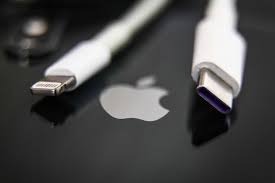Apple’s Use of USB-C in the iPhone 15 Changes the Game for Consumers
Apple’s announcement that it would switch to the USB-C charging connector for the much awaited iPhone 15, scheduled for delivery in 2023, is a ground-breaking decision.
With this change, Apple’s exclusive Lightning connection, which has been the norm for iPhones since 2012, is markedly no longer used. The adoption of USB-C marks a victory for customers, with significant advantages set to transform the iPhone experience.
With Apple’s move to USB-C, everyone will be able to charge their devices. Because Lightning connectors are only available from Apple, iPhone customers are now bound to their brand of chargers.
iPhones may now easily be charged with any charger that supports the widely used USB-C standard. The increased flexibility is particularly helpful for those who use many devices and travel often.
The incredible power delivery capabilities of USB-C, which can sustain up to 100 watts, herald in a new age of quick charging. While the maximum power output of Apple’s Lightning connection is 18 watts. iPhones will recharge much more quickly as a result of the introduction of USB-C, giving users a quicker and more convenient charging experience.
The seamless, quick transfer of data between iPhones and other devices is about to become a reality. The quick and effective data transmission capabilities of USB-C will take the place of the existing slow and laborious data transfer technique. Users should anticipate improved user-friendly interactions with their devices, including easier picture transfers and data synchronization.
A potential chance to reduce electrical waste is the switch to USB-C. By standardizing their electronic accessories, consumers won’t need to assemble a wide variety of chargers for their iPhones and other gadgets. This action supports worldwide initiatives to reduce e-waste and promote sustainability.
Since USB-C is a widely accepted standard interface, a broad range of products outside of Apple’s ecosystem may use it. The introduction of USB-C increases the interoperability of customers’ electronic life by making iPhones more compatible with a wider variety of devices.
In contrast to their Lightning cousins, USB-C connections are famous for their strength and endurance. They are less likely to break and need regular replacement since they are less prone to wear and strain. Consumers looking for long-term value from their products benefit greatly from this natural resiliency.
Apple’s adoption of USB-C goes beyond the benefits that will be seen by consumers right now. It is consistent with more general industry norms and trends, promoting a more unified technological environment. As USB-C spreads more widely, it encourages efficiency, ease, and compatibility across the digital world.
Consumers will never experience an iPhone the same way again thanks to Apple’s adoption of USB-C in the iPhone 15. The change heralds improved cross-device interoperability, faster charging rates, simplified data transmission, less e-waste, and increased durability.
Beyond these immediate advantages, the decision is in line with changing industry norms, promoting a more connected and consumer-focused digital environment. In short, Apple’s adoption of USB-C is a huge victory for the tech-savvy consumer of today and future.







